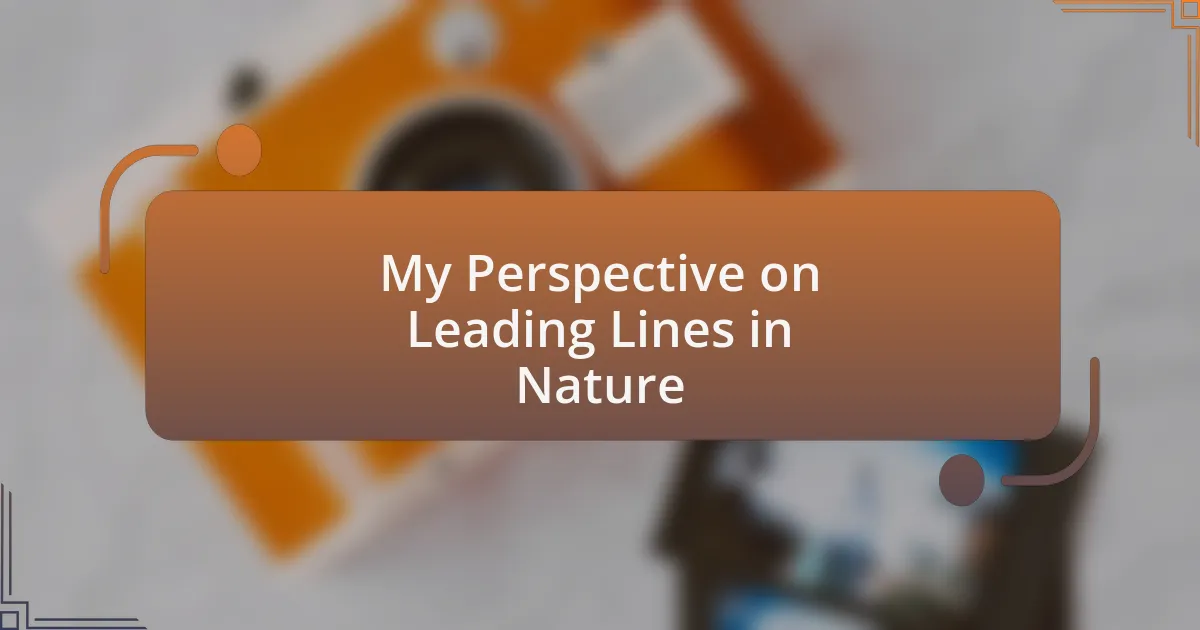Key takeaways:
- Leading lines in photography guide viewers’ eyes, enhancing depth and perspective in compositions.
- Effective techniques include scouting different perspectives, using natural elements for depth, and capturing urban architecture to evoke emotional responses.
- Personal experiences with leading lines reveal their power to convey stories and emotions, transforming ordinary scenes into captivating images.
Author: Clara Ashton
Bio: Clara Ashton is a contemporary fiction author known for her evocative storytelling and richly drawn characters. With a degree in English Literature from the University of California, Berkeley, Clara combines her passion for writing with a deep understanding of narrative structure. Her debut novel, “Whispers of the Forgotten,” received critical acclaim for its poignant exploration of love and loss. Clara’s work has been featured in several literary journals, and she regularly contributes essays on the writing process. When she’s not crafting her next tale, Clara enjoys hiking in the Pacific Northwest and sipping artisanal coffee in local cafes. She currently resides in Portland, Oregon, with her two rescue dogs, Max and Bella.
Understanding leading lines in photography
When I first discovered leading lines in photography, it felt like a revelation. I started noticing how they guide the viewer’s eye through the scene, creating a sense of depth and perspective that draws you in. Have you ever taken a photo and felt something was missing? Often, incorporating leading lines can transform an ordinary landscape into something captivating.
One of my favorite memories is hiking through a dense forest, where the path snaked around towering trees. I remember positioning my camera to capture the trail extending into the distance, creating a stunning leading line that invited viewers to wonder where the path would lead. This experience taught me that these lines are not just about aesthetics; they convey a story, inviting the audience to explore beyond the frame.
Understanding how to use leading lines effectively can change your composition drastically. They can be horizontal, vertical, or diagonal, each evoking different emotions and moods. I’ve found diagonal lines, in particular, invigorating because they bring a dynamic energy to a photo, making it feel alive. Can you think of a moment when a simple line in a photograph resonated deeply with you? That connection between the line and the emotion captured is what makes leading lines so powerful in photography.
Techniques for capturing leading lines
To effectively capture leading lines, I’ve learned to always scout for interesting perspectives before I even raise my camera. Once, while visiting a coastal cliff, I noticed a winding staircase leading down to the beach. By framing the shot to emphasize the steps, I created a strong leading line that not only directed the viewer’s gaze but also sparked a sense of adventure. Have you ever considered how your positioning can redefine a scene?
Another technique involves using natural elements to create depth. On a recent trip to a golden wheat field, I crouched low to the ground, using the rows of wheat as leading lines drawing the eye towards a distant barn. This not only added layers to my composition but also evoked the warmth and tranquility of the rural landscape. Doesn’t it feel rewarding when you can convey the essence of a place through such simple elements?
Lastly, experimenting with leading lines in urban settings can be thrilling. I vividly recall standing in the midst of a bustling city, with skyscrapers casting lines that seemed to converge towards the horizon. By capturing these architectural lines, I could encapsulate both the energy of city life and a sense of infinite possibility. Have you ever thought about how urban environments offer a different take on the concept of leading lines? It’s fascinating how the same principle can yield varied emotional responses depending on the context.
Personal experiences with leading lines
While hiking in the mountains, I stumbled upon a narrow, winding trail that framed the vibrant landscape beautifully. As I captured the path snaking through the trees, I felt a wave of excitement. It was as if the trail was inviting viewers to walk alongside me, sparking curiosity about what lay ahead. Have you ever noticed how a simple path can evoke a sense of journey and adventure?
I also remember a quiet morning at a tranquil lake where a wooden dock extended into still waters. I aimed my camera at the dock, leading the eye to the mist rising from the lake’s surface. This scene resonated with me deeply, as the leading line amplified the feeling of serenity and solitude that enveloped that moment. Isn’t it fascinating how the right composition can encapsulate emotions we often find difficult to express?
On a more spontaneous outing, I found myself in a rainy urban alley, where puddles formed reflective pools. As I captured the reflections of vibrant graffiti on the wet pavement, the leading lines created by the buildings drew my gaze towards the artwork. It felt magical to transform an ordinary, dreary day into something visually striking. How can something so simple, like a reflection, craft a story and elicit an emotional response?
